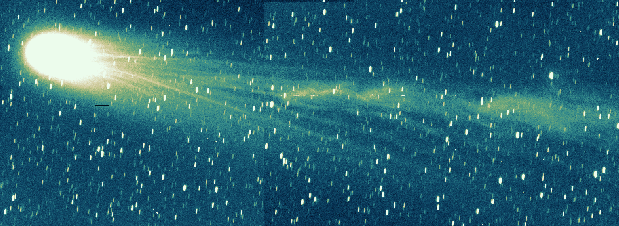Astronomy Picture of the Day
Discover the cosmos!
Each day a different image or photograph of our fascinating universe is
featured, along with a brief explanation written by a professional
astronomer.
March 23, 1996

Comet Hyakutake's Past and Future
Credit and Copyright:
Herman Mikuz,
Crni Vrh Observatory,
Slovenia
Explanation:
The above false-color picture of Comet Hyakutake taken just two days
ago shows its rapidly developing tail. The comet now has a substantial
coma with
a bright center, lending it a
dramatic eye-like appearance.
This is not
Comet
Hyakutake's first visit to the inner Solar System.
Recent
orbital determinations clearly show
Comet
Hyakutake's was here
before, although the previous approach is estimated to be about 8600
years ago - during the epoch of the first recorded human cities.
Were this the comet's first trip to the
inner Solar System, it probably
would not appear as bright as it does now - first time comets typically do
not shed as much luminous gas as veterans. Before making any approach
to the inner Solar System,
Comet
Hyakutake was dormant in the
Oort
cloud of the outer Solar System for a few
billion years, along with hundreds of thousands of similar comets.
Comet Hyakutake is predicted to become the brightest comet since
Comet West
in 1976, which rivaled the brightest stars in the sky.
Tonight,
Comet Hyakutake can be seen best
from about 10 pm
near the Big Dipper's handle.
Latest Comet Hyakutake images:
Crni Vrh Observatory,
Slovenia,
Fayetteville
Observer-Times
Tomorrow's picture: Comet Hyakutake's Closet Approach
| Archive
| Index
| Search
| Glossary
| Education
| About APOD |




Authors & editors:
Robert Nemiroff
(GMU) &
Jerry
Bonnell (USRA).
NASA Technical Rep.:
Sherri
Calvo.
Specific rights apply.
A service of:
LHEA
at
NASA/
GSFC




